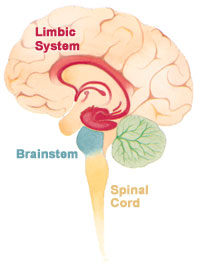Papez circuit
| Papez circuit | |
|---|---|

The structures of the Papez circuit in the brain form a limbus shape around the brainstem
|
|
|
Anatomical terminology
[]
|
The Papez circuit (or medial limbic circuit) (pronounced /peɪpz/.), is a neural circuit for the control of emotional expression. In 1937, James Papez proposed that the circuit connecting the hypothalamus to the limbic lobe was the basis for emotional experiences. Paul D. MacLean reconceptualized Papez’s proposal and coined the term limbic system. MacLean redefined the circuit as the "visceral brain" which consisted of the limbic lobe and its major connections in the forebrain – hypothalamus, amygdala, and septum. Over time, the concept of a forebrain circuit for the control of emotional expression has been modified to include the prefrontal cortex.
Recent studies show that it has a more significant role in memory functions than in emotions. Some of the structures that Papez originally described such as the hippocampus now appear to have little to do with emotional behavior.
The Papez circuit involves various structures of the brain. It begins and ends with the hippocampus (or the hippocampal formation). Fiber dissection indicates that the average size of the circuit is 350 millimeters. The Papez circuit goes through the following neural pathway:
hippocampal formation (subiculum) → fornix → mammillary bodies → mammillothalamic tract → anterior thalamic nucleus → cingulum → entorhinal cortex → hippocampal formation.
...
Wikipedia
